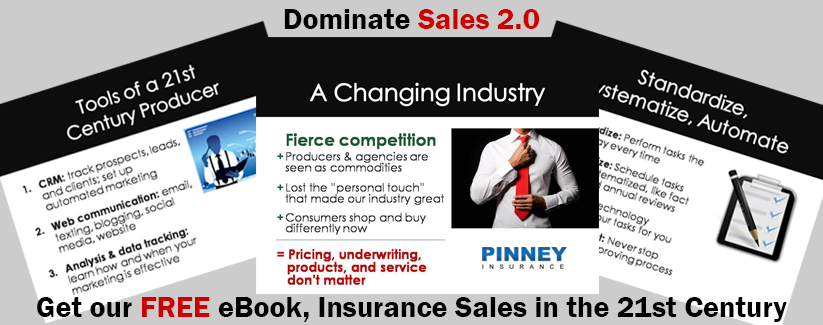The Wedge by Randy Schwantz takes aim at a particular aspect of prospecting: winning a client when there are other interested parties, including an incumbent agent.
This isn't the most delicate of topics, but let’s face it – it's one we’ve probably all run into in our careers. Interestingly enough, a lot of the books we've read aren’t specifically directed at the insurance industry, but this one is. The author describes a process that successful insurance agents use to win new business: (1) researching a potential client, (2) building rapport, and (3) finding the client’s inner dissatisfaction in their current relationship. As the title implies, this process is called “the wedge.”
So...what is "the wedge" and is it right for you?
How the Wedge Works
This is a very disciplined sales method. The trickiest part of the process? You have to guide your prospective client to an aha! moment where they see your competition’s weakness without you having to say it. Basically, you’re giving your prospect a way to ask you for help. To start out, you have to develop an honest relationship with your prospect and build trust through open dialogue. That way, the prospect wants to hire you. You don’t have to go through an awkward and ineffective hard sell, which only makes the prospect feel bad - like he has to hire you, or he’s doing his company a disservice. Instead, you want the client excited about the decision to hire you, which comes from leading them to the conclusion instead of banging them over the head with it.
Successful producers don't just happen. They have personal goals that are enormously important, and they use their business as a means to achieve them. They are investors in the market and in their businesses, but mostly in themselves.
The best way to do this, Schwantz, says, is to ask the right questions during the sales interview.
This reminds us of the Challenger approach – the reason the Challenger makes the sale is often because he makes his prospect uncomfortable and challenges the norm, but in the end, brings the client around to a new way of thinking. Surprisingly, "the wedge" sounds less disruptive to the prospect, but it has the same end goal.
To pull this off, you're going to have to be a little crafty.
Why crafty?
Because you're intentionally driving a "wedge" between your prospect and their incumbent insurance agent.
You know your prospect is going to take your best offer to the incumbent agent, who will then do their best to argue against your selling points. Since you won't be there when that happens, you have to be proactive. You have to tell your prospect in advance that your competition will bring up negative factors about you, your organization, your price, or your product. This is all part of the dialogue that builds trust and confidence in you. When an incumbent agent brings up the objections you said they would, your prospect feels gratified. He or she knew this would happen, and as a result, feels confident in your abilities.
Will This Approach Work for You?
It depends – how willing are you to do your homework? This is a research-intensive method. You need to have not only a deep understanding of your prospective client and their pain points, but the selling points of your competition. According to Schwantz, if you know everything there is to know about your product, service, and company, it’s not enough – because you still don’t know enough about your prospect. He calls this the difference between “selling” and “winning.”
But now, rather than having random goals of do better, make more, be a high achiever, I had a goal that was personal. It wasn't just about me, it was about my family.
Personal motivation is what Schwantz believes sets “winners” apart from, well, losers. The agents who use the wedge successfully are driven by concrete personal goals. Surprisingly, goals that extend beyond a 12-month period are rare, he says. Out of 3,000 producers he spoke to, fewer than 10% had long-term financial goals and a plan to achieve them. To be truly effective using this method, you have to be stone-cold committed to increasing your income.
If that sounds cold or calculating, take a moment to think about what's behind someone's personal financial goals. Schwantz's own aha! moment came when a financial planner told him how much money he’d have to save per year to provide a car, a college education, and a wedding for each of his daughters, while saving for his own retirement. It wasn't a random desire for more money that motivated Schwantz - it was specific goals he had for his family's future. According to Schwantz, it's that tangible number or goal that drives a successful agent.
The Bigger Picture
Earning new business is just part of the author's "iWIN" process - increasing your wealth, income, and net worth. On one hand, this is just basic human psychology - of course we all want to make more money and take better care of our families.
But we think helping people also enters into the equation. We like knowing we play a part in helping families protect their loved ones. We love seeing the Real Life Stories posted by LifeHappens. Even when we're dealing with corporate clients, there are still real people behind the paperwork. That's why we do this.
"The wedge" is one more tool to consider using based on a particular situation or prospect. Use it when it makes sense. Yes, you can be motivated by your personal financial goals, but you can also take pride in knowing that we help people protect the dreams they've built, whether that's a family or a business.
If you feel the same, we'd love for you to join the Pinney team. Click here to learn more and find out how to get started.

